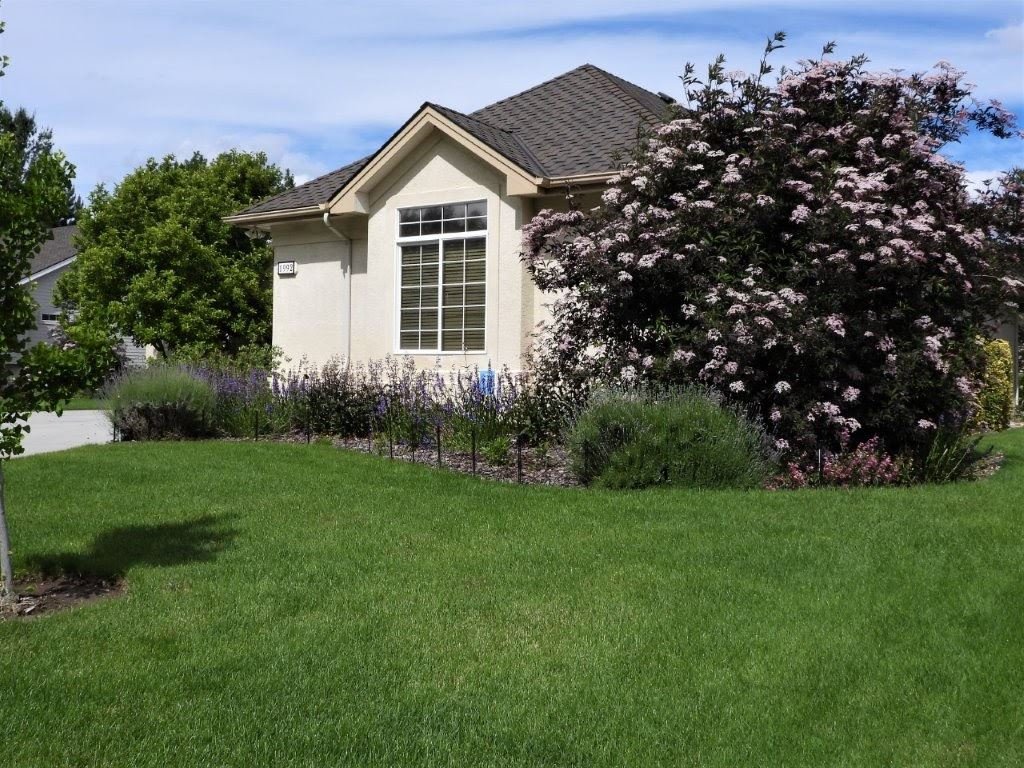Bird-Friendly Backyards: Alex Takasugi
This is a continuation of our National Pollinator Week series in which we interview GEAS members about how they have incorporated native plants into their backyards.
Interview with Alex Takasugi, GEAS Member and Former Board Member
What inspired you to incorporate native habitat into your yard?
First off, not all my plants are natives (Western US). My aim was to make a pollinator/bird-friendly habitat that provides food all season long. Most of the larger items are area natives—Douglas Hawthorn, Red-twig Dogwood, Golden Currant, Syringa, Showy Milkweed—but I also put in things like Pawpaw trees and Elderberry bushes that are native to the eastern US.
Tell us a little bit about the background story of your backyard habitat.
I retired in 2010 and took over the yard work (my husband grew up on a farm and had had his fill of outdoor labor, so he does the housework). After a few years, I realized how much I hated trimming the bushes and it occurred to me that I didn’t have to keep them, I could change the whole thing if I wanted. So, in 2014, I tore out all the bushes in the front of the house, ripped up the weed barrier, tilled in new garden soil and covered everything in bark. I finished the first pass, the front of the house, before July. It just took off from there.
Because I love a good research project, I actually spent 6-8 weeks sitting on the patio before supper each night going through the Sunset Western Garden book and making a list of all the plants that grew in our area and which had the bee/bird/butterfly symbols. Once I had the list, I went online and researched them to find the best types, the ones that bloomed the longest or provided good fruit. Finally, I looked for places to buy seeds for them. Because I started most of the non-bushes from seeds, it didn’t cost a lot. I hit the native plant society sale for most of the bushes. I’m also a fan of the “death row” Labor Day sales at nurseries—my honeysuckles came from there; they looked ratty but are now beautiful.
I can’t put a time frame around it, as the project is never done. One of the best features of gardening is that you learn new things every year, and you can always edit your plants. Some things work out, some don’t. I love to be outside, so it’s not a chore, but more of an enjoyable hobby.
What has been the most challenging aspect of having native plant species in your yard?
Actually, the biggest challenge is having too much water. The neighbors’ houses were built after ours and their contractors graded their yards to slope down to mine, so I’m always dealing with too much water. I’m still working on a drain system for the one side.
What is your favorite part of having native habitat in your yard?
I like the colorful flowers and the bees, as well as the birds. I have tons of penstemons, and I sit by them and watch the hundreds of bees working. Someone always eats the berries (elderberries, hawthorn berries, serviceberries, currants) and the plants are just getting started producing. I love hummingbirds, and they have a seasonal banquet—first the penstemons and honeysuckle, then the bee balm and salvia, agastache and zauschneria and lobelia, all with big red trumpet flowers. In late summer, the echinacea are going. There’s always something to eat. There are plenty of bugs to eat too, both for the birds and my recent guests, the toads. The bushes they replaced did nothing for any wildlife and were as useless as a patch of lawn.
What would you tell someone who is considering incorporating more native plants in their outdoor space?
Start small! Replace one or two things and take it from there. When I put in my first Elderberry, neighbors asked me what it was because it was so beautiful. I had the time and interest to treat it as a big research/work project, but you certainly don’t have to.
Also, native or not, don’t forget shelter. I have a lot of birds because I have a lot of places they can hide, like big hedges and the rhododendrons next to the house, which are the chickadee clubhouse in the winter. My feeders are near big conifers, so when the hawk blasts through, there’s a place to escape to.
Although I would ordinarily never recommend a book I haven’t read yet (I’ve just bought these and flipped through them prior to in-depth reading), I would recommend either or both books by Douglas Tallamy—Bringing Nature Home and his new Nature’s Best Hope—for inspiration. They have lots of pictures and Mr. Tallamy explains WHY we should be doing this, and BNH has suggestions on what to plant by region. Unfortunately, the Intermountain West is not one of his regions, but you can find lots of recommendations locally. I will be using these books to “edit” the landscape as I go on.
Alex’s Plant List:
Trees and bushes:
Douglas or Black Hawthorn
Pawpaw (3 kinds)
Syringa
Golden Currant
Red-twig Dogwood
Black Elderberry (regular and laceleaf)
Rhododendrons
Winterberries (just put in 3, these need a male to pollinate)
Honeysuckle (Dropmore Scarlet, 2 plants)
Flowers:
Penstemons (many, many different kinds, mostly blue/violet, some red)
Agastache, especially Apache Sunset
Rudbeckia (brown-eyed Susans)
Showy Milkweed
Butterfly weed
Gaillardia
Bee Balm (3 kinds)
Echinacea, mostly Cheyenne Spirit
Orange Globemallow
Evening Primrose
“Red birds in a tree” plant
Salvia with red flowers, trying Windwalker because they’re supposed to be perennial, but also annual
S. coccinea (aka Texas hummingbird sage)


